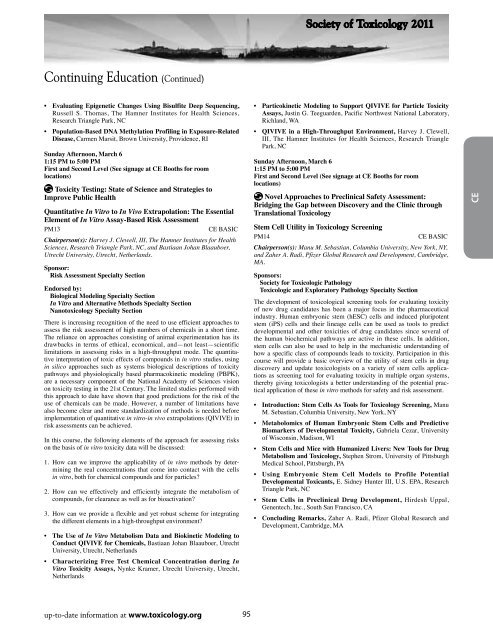Program - Society of Toxicology
Program - Society of Toxicology
Program - Society of Toxicology
You also want an ePaper? Increase the reach of your titles
YUMPU automatically turns print PDFs into web optimized ePapers that Google loves.
<strong>Society</strong> <strong>of</strong> <strong>Toxicology</strong> 2011<br />
Continuing Education (Continued)<br />
• Evaluating Epigenetic Changes Using Bisulfite Deep Sequencing,<br />
Russell S. Thomas, The Hamner Institutes for Health Sciences,<br />
Research Triangle Park, NC<br />
• Population-Based DNA Methylation Pr<strong>of</strong>iling in Exposure-Related<br />
Disease, Carmen Marsit, Brown University, Providence, RI<br />
Sunday Afternoon, March 6<br />
1:15 PM to 5:00 PM<br />
First and Second Level (See signage at CE Booths for room<br />
locations)<br />
Toxicity Testing: State <strong>of</strong> Science and Strategies to<br />
Improve Public Health<br />
Quantitative In Vitro to In Vivo Extrapolation: The Essential<br />
Element <strong>of</strong> In Vitro Assay-Based Risk Assessment<br />
PM13<br />
CE Basic<br />
Chairperson(s): Harvey J. Clewell, III, The Hamner Institutes for Health<br />
Sciences, Research Triangle Park, NC, and Bastiaan Johan Blaauboer,<br />
Utrecht University, Utrecht, Netherlands.<br />
Sponsor:<br />
Risk Assessment Specialty Section<br />
Endorsed by:<br />
Biological Modeling Specialty Section<br />
In Vitro and Alternative Methods Specialty Section<br />
Nanotoxicology Specialty Section<br />
There is increasing recognition <strong>of</strong> the need to use efficient approaches to<br />
assess the risk assessment <strong>of</strong> high numbers <strong>of</strong> chemicals in a short time.<br />
The reliance on approaches consisting <strong>of</strong> animal experimentation has its<br />
drawbacks in terms <strong>of</strong> ethical, economical, and—not least—scientific<br />
limitations in assessing risks in a high-throughput mode. The quantitative<br />
interpretation <strong>of</strong> toxic effects <strong>of</strong> compounds in in vitro studies, using<br />
in silico approaches such as systems biological descriptions <strong>of</strong> toxicity<br />
pathways and physiologically based pharmacokinetic modeling (PBPK),<br />
are a necessary component <strong>of</strong> the National Academy <strong>of</strong> Sciences vision<br />
on toxicity testing in the 21st Century. The limited studies performed with<br />
this approach to date have shown that good predictions for the risk <strong>of</strong> the<br />
use <strong>of</strong> chemicals can be made. However, a number <strong>of</strong> limitations have<br />
also become clear and more standardization <strong>of</strong> methods is needed before<br />
implementation <strong>of</strong> quantitative in vitro-in vivo extrapolations (QIVIVE) in<br />
risk assessments can be achieved.<br />
In this course, the following elements <strong>of</strong> the approach for assessing risks<br />
on the basis <strong>of</strong> in vitro toxicity data will be discussed:<br />
1. How can we improve the applicability <strong>of</strong> in vitro methods by determining<br />
the real concentrations that come into contact with the cells<br />
in vitro, both for chemical compounds and for particles?<br />
2. How can we effectively and efficiently integrate the metabolism <strong>of</strong><br />
compounds, for clearance as well as for bioactivation?<br />
3. How can we provide a flexible and yet robust scheme for integrating<br />
the different elements in a high-throughput environment?<br />
• The Use <strong>of</strong> In Vitro Metabolism Data and Biokinetic Modeling to<br />
Conduct QIVIVE for Chemicals, Bastiaan Johan Blaauboer, Utrecht<br />
University, Utrecht, Netherlands<br />
• Characterizing Free Test Chemical Concentration during In<br />
Vitro Toxicity Assays, Nynke Kramer, Utrecht University, Utrecht,<br />
Netherlands<br />
• Particokinetic Modeling to Support QIVIVE for Particle Toxicity<br />
Assays, Justin G. Teeguarden, Pacific Northwest National Laboratory,<br />
Richland, WA<br />
• QIVIVE in a High-Throughput Environment, Harvey J. Clewell,<br />
III, The Hamner Institutes for Health Sciences, Research Triangle<br />
Park, NC<br />
Sunday Afternoon, March 6<br />
1:15 PM to 5:00 PM<br />
First and Second Level (See signage at CE Booths for room<br />
locations)<br />
Novel Approaches to Preclinical Safety Assessment:<br />
Bridging the Gap between Discovery and the Clinic through<br />
Translational <strong>Toxicology</strong><br />
Stem Cell Utility in <strong>Toxicology</strong> Screening<br />
PM14<br />
CE Basic<br />
Chairperson(s): Manu M. Sebastian, Columbia University, New York, NY,<br />
and Zaher A. Radi, Pfizer Global Research and Development, Cambridge,<br />
MA.<br />
Sponsors:<br />
<strong>Society</strong> for Toxicologic Pathology<br />
Toxicologic and Exploratory Pathology Specialty Section<br />
The development <strong>of</strong> toxicological screening tools for evaluating toxicity<br />
<strong>of</strong> new drug candidates has been a major focus in the pharmaceutical<br />
industry. Human embryonic stem (hESC) cells and induced pluripotent<br />
stem (iPS) cells and their lineage cells can be used as tools to predict<br />
developmental and other toxicities <strong>of</strong> drug candidates since several <strong>of</strong><br />
the human biochemical pathways are active in these cells. In addition,<br />
stem cells can also be used to help in the mechanistic understanding <strong>of</strong><br />
how a specific class <strong>of</strong> compounds leads to toxicity. Participation in this<br />
course will provide a basic overview <strong>of</strong> the utility <strong>of</strong> stem cells in drug<br />
discovery and update toxicologists on a variety <strong>of</strong> stem cells applications<br />
as screening tool for evaluating toxicity in multiple organ systems,<br />
thereby giving toxicologists a better understanding <strong>of</strong> the potential practical<br />
application <strong>of</strong> these in vitro methods for safety and risk assessment.<br />
• Introduction: Stem Cells As Tools for <strong>Toxicology</strong> Screening, Manu<br />
M. Sebastian, Columbia University, New York, NY<br />
• Metabolomics <strong>of</strong> Human Embryonic Stem Cells and Predictive<br />
Biomarkers <strong>of</strong> Developmental Toxicity, Gabriela Cezar, University<br />
<strong>of</strong> Wisconsin, Madison, WI<br />
• Stem Cells and Mice with Humanized Livers: New Tools for Drug<br />
Metabolism and <strong>Toxicology</strong>, Stephen Strom, University <strong>of</strong> Pittsburgh<br />
Medical School, Pittsburgh, PA<br />
• Using Embryonic Stem Cell Models to Pr<strong>of</strong>ile Potential<br />
Developmental Toxicants, E. Sidney Hunter III, U.S. EPA, Research<br />
Triangle Park, NC<br />
• Stem Cells in Preclinical Drug Development, Hirdesh Uppal,<br />
Genentech, Inc., South San Francisco, CA<br />
• Concluding Remarks, Zaher A. Radi, Pfizer Global Research and<br />
Development, Cambridge, MA<br />
CE<br />
up-to-date information at www.toxicology.org<br />
95
















